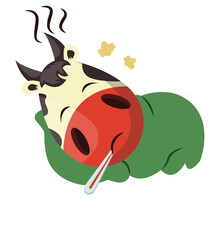Clostridial diseases are caused by a family of bacteria recognised for rapid growth and overwhelming blood poisoning. They can cause some very nasty tissue swelling and death is a common outcome. Species other than cattle can be affected, and some diseases (eg Tetanus) are caused by the same bacteria in many species, including man. If cases are treated early they may respond to high doses of penicllin, but usually it is too late by the time they are noticed. The most fortunate thing about them is that we can vaccinate, and vaccination lasts for life.
Clostridial organisms are commonly found in soil, water and rotting plant/animal material. Animals dying of clostridial diseases often swell up and rot very quickly. Diagnosis is usually at post mortem. The bacteria are not contagious and clostridial diseases generally occur in small numbers. Animals are frequently in good condition and well fed. Clostridia have a hardy spore forming capability which means they can survive in the soil for decades and recur in certain properties. In Australasia the diseases are, in order of importance:
Blackleg - Animals eat the spores of Clostridium chauvoei, which enter via the gut and lodge in the muscles with no ill effects. Sometime later if the animal gets bruised (often in the leg, but also in the back, tongue or jaw), the spores come to life in the anaerobic muscle. They multiply rapidly, rotting the muscle and their toxins kill more muscle tissue and eventually affect the whole animal.
The animal may be lame for a few hours in the affected leg, but usually dies quickly and the post-mortem shows black muscle tissue where the bruise was.If there is a traumatic event such as yarding this may cause outbreaks of blackleg, but otherwise there are only a few animals affected.Malignant Oedema - MO is very similar to blackleg, but is associated with a history of recent deep penetrating wounds such as vaccination, castration and calving. Rather than a discrete area of muscle affected, swelling, gas and oozing bloody fluid spreads rapidly around body connective tissue
Sudden Death Syndrome - A recent syndrome, studied in New Zealand where rapidly growing, very well fed young (mainly beef) cattle have died have been put down to Clostridium sordellii. It is believed the bacteria multiply rapidly in the rich environment of the gut, leaking in to the tissues and multiplying from there. The disease can be confused with bloat, so a careful post mortem is advisable.
Black disease - Clostridium novyi spores lodged in the liver are triggered to start multiplying by liver fluke damage. Affected animals die rapidly from liver failure, peritonitis and heart infection. After death the whole carcase may appear black. This disease is more common in Australia than New Zealand. Unlike other clostridial disease, annual booster vaccinations are recommended if the disease is common.
Enterotoxaemia - Similar to the disease pulpy kidney in sheep, well fed rapidly growing young animals get a gut infection of Clostridium perfringens. Large amounts of the toxin spread to the kidney and heart. At post-mortem there is haemorrhage in the abomasums (4th stomach) and small intestine, with small amounts of creamy feed mix.
Tetanus - Tetanus is not so much a cause of sudden death, but of muscular stiffness, lockjaw and bloat (spasm of the rumen). It takes some days to develop, and is not necessarily fatal. Caught early, cases will respond to penicillin and supportive treatment.
Small wounds, such as castration, docking and dehorning which get contaminated with spores from the soil are the inciting cause.Botulism - The bacteria Clostridium botulinum causes a flaccid “flat” paralysis of muscles due to a nerve toxin. Unlike the other clostridial diseases, it results from eating toxic material. This may be feedstuffs with rotting plant or animal material or contaminated water. Outbreaks can occur in phosphorus deficient environments where cattle are prone to chewing bones, and around waterholes where dead wildlife may contaminate.
Botulism may cause sudden death where large doses of the toxin are ingested, but where smaller doses are taken the clinical signs mimic milk fever. Outbreaks may have high numbers of deaths initially but sublethal cases continue for weeks afterwards. The sublethal form produces a creeping paralysis, initially of the hind legs, but then the front legs. The tongue may protrude, with drooling and inability to swallow. Many animals eventually die, but some survive with supportive treatment.Botulism can be prevented by vaccination and/or preventing contamination of feed and water. It is particularly important to keep the bones of dead animals and chicken litter out of feed. Supplementary feed with clean sources of protein and phosphorus if the diet is deficient.

